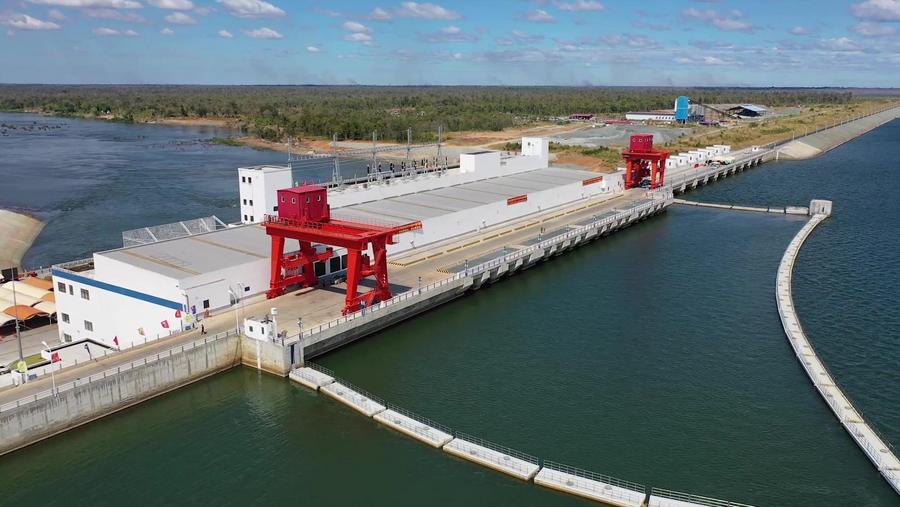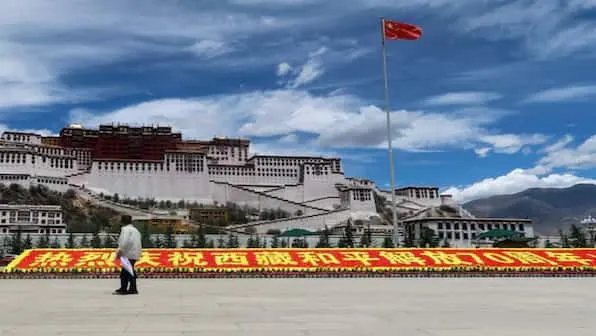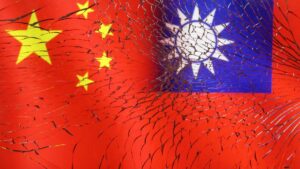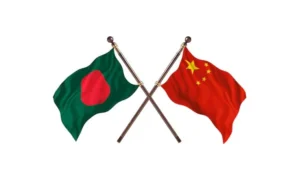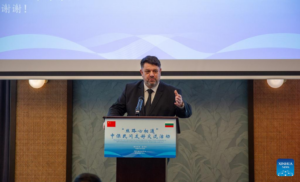How Beijing employs economic statecraft through inducements
Executive summary
As strategic competition between the United States and China intensifies, Washington and Beijing seek every possible advantage to gain an edge. In this environment, both countries are increasingly turning to economic statecraft—the use of economic coercion or inducement to pursue strategic goals—to advance their interests. Among these tools, economic coercion often garners the most attention, both as a preferred instrument of US policymakers and as a key driver of China’s expanding influence. However, this focus on coercion largely overlooks the strategic value of economic inducements, which serve as a powerful and affirmative means of cultivating influence. These positive measures enable the United States to leverage its economic strengths, advance its global interests, and support recipient countries—all while countering China with a more transparent, sustainable, and effective alternative.
For successive US administrations, the global reliance on US goods and services for economic growth has reinforced Washington’s ability and willingness to employ sanctions, trade restrictions, and unilateral economic measures to shape policy decisions in targeted countries. Meanwhile, decades of steady growth have enabled Beijing to wield its economic power in pursuit of strategic objectives. Considerable attention has been devoted to China’s use of economic influence and its deep integration into the global economy as tools of coercion, with Lithuania, Japan, and Australia among the most prominent targets of Beijing’s economic pressure campaigns. In response, nations worldwide have sought to resist China’s coercive tactics, implementing countermeasures both independently and in coordination with allies and partners.
China’s use of economic inducements, however, remains largely overlooked despite being instrumental in Beijing’s ability to encourage and entice countries into supporting its policies. Through public diplomacy, discourse power, strategic engagement with key constituencies, and coordination of economic activities among China-based entities, Beijing has demonstrated considerable skill in leveraging targeted incentives to persuade leaders—particularly in the Global South—that quid pro quo arrangements with China offer a viable path to economic development and growth. These leaders often view US-China competition as an opportunity to enhance economic outcomes while bolstering their domestic political legitimacy.
Nowhere are the successes of China’s economic inducements more evident than in the gradual erosion of Taiwan’s formal diplomatic relationships. In less than a decade, Beijing has convinced eleven of Taiwan’s former diplomatic partners to switch recognition to China. Many of these shifts were achieved through carefully tailored inducements designed to align political leaders with Beijing’s strategic objectives. Contrary to popular narratives, these inducements were not always overwhelming financial offers or corrupt dealings; rather, Beijing strategically cultivated political and sectoral interests to incentivize a diplomatic realignment. Similarly, China has employed targeted economic inducements to expand its influence in multilateral institutions, garner support for its global initiatives, and secure market access for Chinese firms, among other strategic objectives.
Beijing’s use of economic inducements is particularly effective because China has tailored its measures to align with the specific needs of recipient countries and their leaders or political parties. For politicians in both democracies and authoritarian states, public promises of economic support from Beijing can boost domestic political support and international legitimacy. Even when Chinese projects are later exposed as inefficient or detrimental, their speed, cost efficiency, and willingness to assume risk continue to make them appealing.
Too often, Chinese firms and state-run lenders are perceived as the most viable—or only—option available to Global South countries seeking economic development. Yet the appeal of Western economic engagement remains strong, and Washington should look beyond unilateral coercive measures to offer an affirmative vision of economic development and compelling alternatives to Chinese projects and financing.
Transparency and sustainability are key strengths of US and Western economic initiatives. Collaborating with like-minded allies and partners can enhance the financial viability and long-term success of development projects. The US International Development Finance Corporation warrants greater attention as a critical instrument of US economic statecraft, while US public diplomacy institutions play a vital role in countering Chinese influence and promoting Western-led initiatives. By leveraging targeted inducements, multilateral economic initiatives, and strategic partnerships with like-minded countries, the United States can expand its economic statecraft tool, diminish the appeal of Chinese economic engagement, and advance its interests abroad.
Chapter 1: Introduction
Economic statecraft and US-China competition
The foundation of strategic competition between the United States and China is an unprecedented level of economic interdependence—both with each other and with the global economy. This interdependence, largely sustained by post-World War II institutions, has driven global economic growth for decades. However, it now also enables the more deliberate use of economic ties to pursue strategic and geopolitical objectives.1
Economic statecraft—the use of economic means to pursue political goals—is deployed through two primary levers: coercion and inducement. Of the two, economic coercion has received far more attention in academic literature, policy analysis, and China-specific scholarship. Beijing’s use of economic inducements—both promised and delivered—is less appreciated and relatively unexplored, as is how the United States can employ similar measures to advance its national interests.2
These economic inducements can take a variety of forms: official international assistance or humanitarian aid (such as grants, capacity building, technical assistance, or budget support), development finance (such as loans, credit, guarantees, and public-private partnerships), investment, and access to currency, trade, preferential tariffs, and subsidies are some of the most cited.3 Studies have investigated these mechanisms of influence, including the use of inducements to garner votes in the United Nations and the World Bank.4 Corruption through bribes and kickbacks, political donations, academic donations, and other incentives to buy elite support for the sender’s goals are also forms of inducement.5 Promises—free trade agreements (FTAs), memoranda of understanding (MOUs), market access promises, and signing ceremonies for new economic arrangements—can be a potent incentive, even if the final product is substandard or not completed.
The existing literature divides these inducements into two broad categories: quid pro quo arrangements that involve conditionality and unconditional structural engagement.6 This latter category of inducements creates a commercial motivation to favor the provider of the incentive, in turn building and expanding interest groups in the target country that support closer economic relations with the sending state.7 In reciprocal arrangements—the focus of this study—the provider of the inducement explicitly links the incentive to the desired policy behavior in the recipient country, requiring a clear request (whether in public or private) that can be accepted or denied. While it is important to separate the intent of these two categories of economic inducement, they are also intertwined: broad structural factors can act independently while simultaneously shaping the frameworks for quid pro quo arrangements. Promises of structural engagement—such as pledges to increase trade, investment, or aid in agreements or MOUs—can serve as transactional inducements. However, insufficient follow-through often impedes the sustained alignment of interests and behavior.
Weaponizing US economic statecraft
For decades, US foreign economic policy has often sought to wield the centrality of the US economy and financial system as a weapon to compel desired behavior. Sanctions have been used by the United States across a wide range of issues and are policy tools that can quickly earn broad domestic political support—for both good and ill.8 Their efficacy has long been debated in academic literature, with concrete answers hampered by the evolving nature of sanctions, the difficulties in defining sanctions, economic coercion, and success, as well as the empirical challenges of identifying the full universe of cases.9 More recently, export controls and trade tariffs have come to the forefront as preferred instruments of US economic statecraft, with China as a primary target. These punitive measures seek to blunt the impact of Beijing’s industrial policies and its efforts to bolster its domestic economy at the expense of the United States and other countries.
Concerns about the overuse of economic sanctions and other punitive measures have grown in policy discourse as the unintended consequences of sanctions and potential harms to US foreign policy interests become more apparent.10 In a 2016 speech, then–Treasury Secretary Jacob Lew warned of the risks of sanctions overreach: “[W]e must be strategic and judicious in how we apply sanctions” to avoid driving business activity away from the US financial system.11 Daleep Singh, a former deputy national security advisor for international economics, wrote that “the United States and its partners will need to apply the same creativity and urgency toward developing a positive vision for economic statecraft as they have in designing sanctions and other restrictive measures in the recent past.”12
This is not to say that inducements have not been used at all; the United States has effectively employed such measures before. As detailed in a report from the Atlantic Council’s Geoeconomics Center, there are numerous examples of the United States and the European Union (EU) using “positive economic statecraft” in a variety of contexts. In tactical cases, the United States and the EU linked the provision of aid, finance, or trade to a specific desired outcome or action.13 For example, the United States has conditioned nonmilitary aid to Pakistan on cooperation with counterterrorism efforts; the EU offered Moldova a support package after it joined the EU’s sanctions against Russia in 2023; and a Tax Information and Exchange Agreement between the United States and Panama in 2011 was a prerequisite to a subsequent FTA. The Pakistan and Panama cases indicate that US policymakers have already used economic inducements to great effect and should consider employing them more extensively moving forward.
In other cases, the failure of inducements to entice desired policy changes in North Korea and Iran has perhaps contributed to a decline in their use.14 US economic statecraft was used in attempts to convince Pyongyang and Tehran to abandon the pursuit of nuclear weapons. It is also notable that Chinese economic statecraft toward North Korea has been of questionable influence. China and Russia, likewise, are competitors of the United States for whom the benefits of positive incentives are difficult to envision—except perhaps on extremely specific and discrete issues. Convincing these regimes to accede to US policy demands, however, is a high-stakes outlier in policy—significant enough that failure in this area should not dissuade US policymakers from employing inducements more broadly in foreign policy. There remain opportunities to use positive incentives to advance both US interests and development needs in many countries.
The US focus on sanctions-based economic statecraft has contributed to Washington’s underappreciation of the needs of developing countries. It is difficult to present an affirmative offer to these countries when the United States is so focused on discouraging undesired behavior—most often through threats and sanctions. This has created openings for Chinese inducements, which can significantly influence the policies and behaviors of leaders in countries requiring economic growth and development. Moreover, developing countries’ real or perceived lack of competitive alternatives from Washington and its allies has significant foreign policy and national security implications for the United States. It has been easy to dismiss the geopolitical importance of these small and developing countries. However, in times of great power competition, their role is amplified—they are needed for international support, to combat transnational threats, and as markets for US companies. For example, the Solomon Islands previously received scant attention from the United States, but Beijing’s expanding influence there has raised concerns throughout the Indo-Pacific region that China seeks naval basing rights. Washington’s response to the China-Solomon Islands security agreement signed in April 2022 included warnings about China’s intentions and a belated flurry of diplomatic activity.15 In the decades following the Cold War, the United States was, by default, the most important partner for many countries due to its economic influence and global security interests. However, with China now a near-peer economic competitor, Washington needs to expand its toolkit.
Scope of the study
To the extent possible, this report seeks to establish a clear and direct linkage between China’s strategic intent, the promise and provision of economic inducements, and a discrete outcome—either acquiescence or refusal of Beijing’s demands. Ideally, a specific policy request from China is apparent, as is whether the target country complied. In the absence of such evidence, close process tracing—through interviews, contemporaneous research and reporting, MOUs, and contracts—can help reveal the contours of influence attempts. The potential use of inducements to influence a recipient country to withhold action it might otherwise take makes process tracing particularly valuable, while expert interviews can help uncover such hidden cases. This report benefited from off-the-record interviews in Washington and Taipei with US and Taiwanese officials, academics, journalists, and representatives of several of Taiwan’s current diplomatic partners.
Establishing intent is a fundamental and inextricable challenge in any study of power and influence—a task made even more difficult by China’s opaque state-capitalist system. By focusing on national-level policies in the target country that are of strategic importance to Beijing, this research seeks to circumvent some of these challenges by explicitly analyzing areas where intent is unquestioned. This approach enables a more focused assessment of the factors—both in China’s offer and in the target country—that contribute to success. While this method inherently introduces selection bias, the observational nature of this study, China’s strategic use of diverse tools of economic statecraft, and the immediate policymaking implications of these findings necessitate a targeted analysis.
The focus of this report will be on the effects of publicly announced inducements, though attempts at bribery or elite capture through private rents can also play an important role in China’s economic statecraft strategy. There are pragmatic reasons for the decision to deemphasize corruption—namely, the methodological challenges of identifying under-the-table deals. However, the intent behind dark money is often unrelated to a specific public policy issue or is merely a feature of, rather than the driving force behind, larger announced deals. Publicly announcing these agreements allows the recipient leader or regime to leverage the deal with China to bolster political legitimacy both domestically and internationally. Still, by identifying issue areas where China has strategic intent and process-tracing the events surrounding success (or failure), this report aims to assess the impact and deployment of various inducements, including bribes and corruption.
Chapter 2: Inducements in Chinese economic statecraft
Economic inducements have played an important role in China’s foreign policy strategy for decades, harking back to Mao Zedong’s foreign aid to Africa.16 In recent decades, China’s rapid economic development has led Beijing to use inducements to create an international environment more aligned with its interests.17 Without an extensive array of security relationships, Beijing has been largely dependent on economic arrangements to extend its influence and pursue desired policy change in other countries.18 Since Xi Jinping took power, China has used this strategy more frequently and with greater success, commensurate with the growth of its economy and its increasing importance to global markets.19
For good reason, international attention focuses primarily on the Belt and Road Initiative (BRI) as a potential—and powerful—conduit for Chinese economic influence. Chinese institutions have poured many billions of dollars into BRI projects and the initiative’s constituent parts, from the original Maritime Silk Road and Silk Road Economic Belt to the Digital Silk Road, Polar Silk Road, and Health Silk Road. Beijing claims that more than 150 countries and institutions have signed on to the BRI, and China has introduced the Global Development Initiative (GDI) alongside the BRI to promote economic development in the Global South.20 In recent years, Xi has also launched a slew of complementary initiatives to expand China’s influence, including the Global Security Initiative (GSI), Global Civilization Initiative, and Global Artificial Intelligence Initiative.21
The extensive literature on China’s global economic footprint notes that BRI-associated projects are a ubiquitous aspect of Beijing’s growing influence.22 These studies provide valuable insight into Chinese trade, investment, and/or financing in a specific country, within a wider region, or emanating from a single large-scale initiative such as the BRI. Many of these works use broadly applicable indicators to highlight China’s structural engagement and its resulting influence, and these indicators serve as important context for Beijing’s ability to shape the policies of target states. A 2021 RAND Corporation report emphasizes trade and foreign direct investment as the economic inputs of China’s influence while also highlighting the complexity of the literature on the relationship between influence and economic ties.23 A 2023 RAND Corporation report compares US and Chinese approaches to development highlighting how China blends different forms of economic engagement into its larger portfolio of development cooperation.24 Large databases such as the American Enterprise Institute’s China Global Investment Tracker and AidData offer valuable insights into China’s overseas investment and construction, as well as its development financing.25 These are just a few notable works in this space.
Yet membership in the BRI—most often through the signing of an MOU—is not the only channel for Chinese economic engagement, and not all of this engagement, BRI or otherwise, confers immediate or quid pro quo benefits for Beijing. China’s domestic overcapacity, for example, is often cited as an important driver of Chinese firms’ overseas activities, suggesting that not every investment or trade deal is meant to extend Beijing’s geopolitical influence.26 To some degree, the BRI can be viewed as a political slogan, mobilizing domestic and international actors toward the initiative’s broader goals without directing specific actions.27 The purpose of this report is to highlight this distinction—between non-conditional economic engagement and targeted quid pro quo inducements—as fundamental to the US response to China’s economic statecraft.
China has tied the promise and delivery of specific economic inducements to achieving discrete strategic goals. These quid pro quo arrangements can be obscured in a larger review of China’s economic inputs. In Greece, China’s footprint has grown rapidly following a privatization push after the 2008 Global Financial Crisis. However, as noted in an International Republican Institute report, “Beijing’s influence over government discourse and decision-making in Athens is disproportionate to its level of investment and economic importance in absolute terms.”28Growing trade and investment relations, such as in Greece’s energy sector, serve as the backdrop and conduit for Beijing’s influence, but China’s investment in the port of Piraeus—and the promised economic growth associated with the investment—was the proximate cause of political decisions by Greece in favor of Beijing in the EU.29
Economic inducements, however, are not universally positive for leaders in recipient countries, and China’s infrastructure investments and development projects have rightly received significant attention for their negative externalities. There is an extensive list of projects that have failed to deliver on their promises or have triggered opposition from local communities due to environmental, social, and governance (ESG) concerns, debt distress and difficulty refinancing loans, cost and timeline overruns, imported labor from China, corruption, and other issues.30 These externalities constitute the core of Western warnings to the Global South of Chinese economic influence.
While many countries are now more cautious about accepting Chinese bids—and Beijing has pulled back on some lending in the past few years—in many cases, Chinese projects are either the only option to meet development and infrastructure needs or the most competitive option for emerging economies. Fifth generation (5G) cellular networks, high-speed rail, and port infrastructure are some prominent examples.31 Indeed, Chinese projects can offer ready-made links between state-owned companies and state-owned policy banks, allowing for a streamlined bidding process (or to avoid competitive bidding altogether) and rapid project development.32
These projects’ connections to the Chinese party-state are a leading concern for US and Western policymakers. China’s state capitalist system allows the Chinese Communist Party (CCP) to orchestrate the economic activity of state-run financial institutions, state-owned enterprises (SOEs), and even private corporate entities in a way that the United States and its partners have not matched.33 At the same time, US researchers and policymakers should not assume that China is uniformly intent or effective in its use of economic ties to achieve strategic goals, nor that Chinese corporate entities are eager participants in these endeavors.34 Beijing can encourage economic activity abroad for several possibly overlapping reasons, including strategic gain, national economic strength, and support for Chinese companies abroad.35 Likewise, it is important to interrogate the mechanisms through which Beijing hopes to gain strategically from its economic reach and growth. Outside of coercion and inducements, economic statecraft initiatives can enhance political influence by creating vested interests, transforming public and elite opinion, and giving rise to structural power.36
Even as China faces an economic slowdown, there is little reason to believe that Xi will deemphasize economic statecraft in his foreign policy.37 He is acutely aware that domestic perceptions of foreign policy issues, particularly those related to territorial disputes and political legitimacy, are paramount to the political survival of the CCP. Independent of ongoing struggles in the domestic economy, Beijing has learned from past failures and is reining in some of its more ostentatious projects, shifting toward “smaller” and “greener” programs.38 No longer able to spread economic largesse as widely, China may instead direct its capital toward economically or strategically advantageous projects, fostering more sustainable and targeted engagement.39
Existing research on Chinese economic statecraft and implications for the study of inducements
While the literature on Chinese economic statecraft and coercion is well established, relatively few works specifically examine Beijing’s use of inducements. Scholars of Chinese economic statecraft, however, have produced a robust body of research on Beijing’s use of coercion; these studies, while not focused on inducements, have important implications for the study of positive economic incentives. Recent think tank analyses—including from the Center for Strategic and International Studies, Australian Strategic Policy Institute, and Mercator Institute for China Studies—offer a snapshot of this research.40 Together, these reports and others reveal important trends in China’s use of economic coercion that can be applied to the examination of strategic inducements.
First, the targets of Chinese coercive attempts are somewhat predictable, which likely holds true for inducements as well. These studies note that targets are largely Western-oriented, democratic, and developed. However, what remains unaccounted for is how China exerts influence in the Global South, where Beijing has consistently used positive economic incentives. Second, coercive measures are aimed at strategic industries with a strong political lobby in the target country; similarly, China carefully selects the recipients of economic inducements, targeting leaders, other political elites, and their constituents. Lastly, there are certain issues around which Beijing is likely to exert economic coercive force, including national sovereignty, national security, political legitimacy, and territorial disputes. To gain a full understanding of Beijing’s economic statecraft, it is also important to identify the issues which invite China’s economic inducements.
While there remains a dearth of research explicitly discussing China’s use of economic inducements as part of its larger economic agenda, investigations in this area have been increasing in recent years. This scholarship largely focuses on China’s non-conditional economic engagement or employs broad measures to identify correlations between specific Chinese incentives and policy outcomes. Evelyn Goh, for example, discusses economic inducements as a “preference multiplier” in China’s influence efforts in Southeast Asia, serving to politically advantage actors whose interests align with those of Beijing in a form of non-conditional structural engagement.41 In Africa, Ana Christina Alves argues that China’s development financing for infrastructure projects has had moderate success in achieving tactical and structural goals since the founding of the People’s Republic of China in 1949.42 Dreher et al. argue for a need to differentiate types of Chinese aid to assess their effects on policy in Africa, concluding that China’s Official Development Assistance—though less so commercial loans—is driven by foreign policy considerations.43Several studies examine the limited effectiveness of China’s positive economic efforts to influence Taiwanese elections through strategic agricultural purchases. While these works offer valuable insights, they largely overlook quid pro quo arrangements in favor of statistical correlations.44
Audrye Wong provides an in-depth analysis of the issue, examining when Chinese inducements effectively achieve geopolitical goals.45 She distinguishes between subversive carrots—which circumvent political processes and institutions in target countries—and legitimate seduction, arguing that countries with high-accountability domestic political institutions are less susceptible to subversive carrots. Because of this dynamic, she contends that China has been less successful in achieving influence than commonly assumed. The utility of this framework is clear. However, the intent behind these subversive carrots—often, but not always, involving hidden bribes and corruption—is not explicit, making its application difficult. These subversive carrots are not necessarily directed by the party-state, especially with other economic incentives at play. Even when they are, assessing the desired strategic outcome remains challenging—whether the engagement is non-conditional (such as increasing the market share of a Chinese SOE) or transactional.
This question of intent is one reason to deemphasize—though not discount—the potential effect of subversive carrots. Chinese inducements, particularly those related to the BRI and its infrastructure projects, are undoubtedly crafted to align with the needs and domestic political priorities of elites and decision makers in the target country. This, in turn, creates opportunities for graft, opaque deals, and a lack of accountability.46 However, the assumption that these inducements are primarily intended to advance “strategic corruption”—the explicit use of bribes and elite capture to achieve geopolitical aims—lacks broad support, despite some important high-profile cases.47 In this report, the Solomon Islands and Kiribati are the two most apparent examples of possible corruption, though in both cases there are significant public benefits as well. Most significantly, such corruption is often linked to a Chinese company with a clear economic rationale for the project in question. Chinese inducements can be and have been used to secure lucrative business deals, facilitate personal enrichment for high-level policymakers and commercial actors on all sides, and to expand China’s non-conditional economic engagement. However, there is minimal evidence that these efforts are part of a larger scheme directed by the party-state to exert influence over specific strategic issues.
Explaining the success of Chinese inducements
For leaders and regimes in power, receiving economic inducements can enhance citizen perceptions of a regime’s performance, help secure public compliance, and strengthen both domestic authority as well as external validation of the regime’s position.48 To reap these benefits, leaders in both authoritarian and democratic governments are eager to announce inbound investments, foreign aid, or trade agreements—even if they obscure the longer-term ESG trade-offs, or instances of bribery and corruption, associated with these deals.49 Together, these factors increase the likelihood that the recipient of the inducement—most often the ruling regime—will achieve political stability and maintain its grip on power.
Broadly, China’s economic inducement strategy has been effective because it is sensitive to the domestic political needs of leaders and regimes in recipient states. Beijing promotes itself both as a member and leader of the developing world, free from the colonial and Cold War baggage associated with the United States and other Western institutions. China’s professed adherence to a nonaligned posture further facilitates a persistent diplomatic presence in the Global South and ensures a sympathetic ear for Chinese proposals.50 Moreover, China’s state-owned banks and firms are willing to finance and/or build what recipient countries want, rather than promoting projects that align with a predetermined set of values or development priorities. They also engage with state actors that Western institutions have neglected for various reasons. BRI projects address infrastructure and connectivity needs in developing countries; foreign aid provides a domestic political boost to elites in recipient countries; and promises of increased trade and investment make for good publicity, even when such pledges fail to materialize. These inducements allow for a sustained Chinese presence in a country that can build goodwill and help maintain stable relations.51 While they often advance China’s broader non-conditional engagement objectives, they can also be tailored to meet specific needs.
The Lowy Institute’s Global Diplomacy Index offers a snapshot of China’s efforts in this regard. Beijing holds a slight lead over the United States in overall diplomatic posts (274 versus 271), embassies (173 versus 168), and consulates general (ninety-one versus eighty-three).52 China has more posts in Africa, East Asia, the Pacific Islands, and Central Asia and is tied with the United States in the Middle East and South America. Reporting suggests that Chinese diplomats can be more adept at engaging with locals than the “wolf-warrior diplomacy” narrative of recent years would suggest.53 Beijing has emphasized discourse power as an important aspect of China’s influence abroad and seeks to “tell China’s story well.”54 As detailed by researchers at the Atlantic Council and elsewhere, this discourse power manifests in various forms, including partnerships with local media, ostentatious branding of Chinese projects, the establishment of Confucius Institutes, training centers, province-led international communication centers, and other programs that promote China-affiliated ideas.55
These various connections—diplomatic, commercial, informational, and educational—provide Chinese actors with access to local institutions and leaders, as well as insight into development priorities in recipient countries. The definition of “local” in this context varies widely depending on government structure, leadership dynamics, accountability mechanisms, and public opinion. In some countries, central leaders are the primary decision makers, while in others, municipal policymakers, businesspeople, or community leaders hold greater influence. Regardless of the political structure, China has established mechanisms to assess development needs and identify potential synergies. Beijing has also demonstrated an ability to identify important areas of economic development for targeted countries and take action—whether through vanity projects for leaders or investments in export markets with political significance.
In BRI projects in Southeast Asia, for example, power-holder diplomacy (currying favor with top leaders) and aligning the BRI with a host country’s national strategy or a leader’s vision are two key approaches to generating demand for inducements.56 These strategies highlight crucial aspects of how Beijing has pursued success in its economic statecraft. China has effectively communicated its vision for economic development—including through the BRI, Asian Infrastructure Investment Bank, and other lending institutions—to sympathetic and financially constrained countries. It has also identified critical needs, determined the most effective targets for inducements within domestic political environments, and assessed how these needs align with elite interests in recipient countries. In the Philippines, for example, Beijing actively supported the presidential candidacy of Rodrigo Duterte, who sought a break from the United States and actively courted BRI projects. Once elected, promises from China buttressed Duterte’s “Build, Build, Build” economic development campaign, including infrastructure projects focused on the then president’s home island of Mindanao.57
These aspects of China’s economic statecraft—communication, identification, and assessment—are meaningless without the ability (or a credible promise) to deliver inducements in ways unmatched by Western countries or institutions. In some cases, this is a straightforward process. For example, Cambodia and Prime Minister Hun Sen received foreign aid in exchange for stifling opposition to China’s interests in the Association of Southeast Asian Nations (ASEAN), the region’s primary multilateral grouping. Similarly, as part of the Solomon Islands’ diplomatic switch to China in 2019, Beijing replaced a Taiwanese fund with its own and constructed a grant-funded sports stadium. Meanwhile, Beijing’s unfulfilled promises to Italy enticed Rome—frustrated with Europe’s lack of economic support—to join the BRI.58
Many countries in the Global South require infrastructure and connectivity investment, an area where China’s project development model is often welcomed. In the Xi era, these projects fall under the BRI umbrella, though their core characteristics predate the initiative. As identified in a Council on Foreign Relations Independent Task Force Report on the BRI, these characteristics include state backing and access to cheap credit for Chinese companies, state-owned commercial and policy banks directed by Beijing to embrace BRI projects, a lack of concessionary terms (at least in the contract) that make loans more accessible, and an eagerness to launch projects quickly—often to minimize financial viability assessments or ESG transaction costs.59 Together, these factors enable Chinese projects to move swiftly from planning to construction, with a high tolerance for risk.
Need for further study
Important work has been done to better understand China’s economic statecraft, including valuable scholarship on China’s non-conditional economic engagement and its resulting influence. Yet little attention has been given to how China uses targeted economic incentives to address the immediate development and economic needs of recipient states and, through these measures, alters their policy behavior to align with Beijing’s geopolitical goals.
Since 2016, eleven nations have recognized Beijing, leaving Taiwan with only twelve remaining diplomatic partners. Perhaps most notably, Beijing has successfully enticed several of Taiwan’s diplomatic partners to switch recognition to China by offering public economic incentives that Taiwan and its Western partners choose not to match.60 The president of Paraguay, which continues to recognize Taiwan, made this dynamic explicit when he requested $1 billion in investment from Taipei to help resist Chinese pressure.61 Inducements are an ideal mechanism for enticing Taiwan’s partners to switch, as they align with Beijing’s self-professed support for developing countries and are less likely than coercion to provoke domestic resistance in the recipient country. Taiwan’s diplomatic partners are all small, developing nations, where a relatively small amount of inducements can have a significant impact. There is little doubt that Beijing will continue to use inducements to erode Taiwan’s remaining diplomatic relationships and will press its advantage unless countered by a deliberate effort.
Beijing has also successfully used inducements to gain influence in multilateral fora and shape proceedings in its favor. In Southeast Asia, China is often, and rightly, criticized for its belligerent tactics in the South China Sea; at the same time, it has managed to forestall a strong regional response through the targeted use of inducements to key players in ASEAN, the region’s consensus-based organization.62 Both Cambodia and the Philippines, for example, have moderated their criticism of China or supported its positions based on promised and delivered inducements.63 China appears to be using a similar playbook in the Pacific Islands, where substantial pledges of investment and aid have helped Beijing advance its policy preferences among members of the Pacific Islands Forum.64 Farther afield, China has invested in Central and Southern Europe in an effort to weaken anti-China sentiment in the EU, though with less success.65
In addition, Xi seeks both domestic and international legitimacy through grand, large-scale initiatives. The BRI is the most obvious example, and more recently, China has sought support for its GDI and GSI.66 While these programs have served as vehicles for inducements, Beijing also uses economic incentives to entice noncommittal countries to sign on, bolstering the Chinese party-state’s political legitimacy at home and abroad. When Italy joined the BRI in 2019—the first Group of Seven (G7) government to do so—the move was highly touted by Beijing. Italy’s leaders were lured by promises of trade and investment, but the benefits were scarce. Italy withdrew from the initiative in 2023.67
The following two chapters will examine episodes in which China has successfully—or unsuccessfully—used positive incentives to induce desired changes in policy. Chapter 3 takes an in-depth look at the circumstances of Taiwan’s recent diplomatic losses and the prospects of maintaining its remaining partners; it concludes by addressing arguments about the relative importance of the formal diplomatic relations. Chapter 4 reviews several additional cases, expanding on China’s efforts in ASEAN, Italy, and other countries. Beijing’s use of quid pro quo inducements to achieve strategic goals should be of great concern to the United States as Washington seeks to counter Chinese influence.
Both China’s supply of positive inducements and the recipient country’s demand are necessary components of Beijing’s economic statecraft. Beijing has demonstrated a sensitivity to the political motivations and institutions of recipient countries that influence the acceptance or rejection of its strategic inducements. Further research into the development of China’s economic inducements—including communication of offers, identification of elites, and assessment of domestic needs, in addition to promise and delivery—would help shed light on how China is achieving strategic success and what factors the United States should prioritize in crafting an effective response

